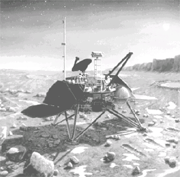Mission to Mars
 for the National Space and Aeronautics Administration (nasa ), 1999 began with a bang. On January 4, the ambitious Mars Polar Lander took off successfully from the Kennedy Space Centre at Cape Carnival, Florida, usa. It is expected to touch down on Mars on December 3, 1999, after releasing a set of two mini-probes called deep space-2. These will embed themselves into the Martian terrain.
for the National Space and Aeronautics Administration (nasa ), 1999 began with a bang. On January 4, the ambitious Mars Polar Lander took off successfully from the Kennedy Space Centre at Cape Carnival, Florida, usa. It is expected to touch down on Mars on December 3, 1999, after releasing a set of two mini-probes called deep space-2. These will embed themselves into the Martian terrain.
Once on Mars, the Lander, with the help of a robot arm, will collect rocks and soil samples. The spacecraft will be search the soil for water in the form of ice crystals. "Water is a key ingredient for life, as well as an important resource for human explorers who may visit Mars in the distant future,' said a spokesperson of nasa . The deep space-2 mini-probes, which the Lander will release before landing, will do the same with underground samples. Earlier, nasa launched the Mars Climate Orbiter on December 11. It will start orbiting Mars on September 23, 1999, and study the Martian seasons and search for traces of water on the Red Planet.
Firing of the first-stage engine of the Mars Polar Lander lasted approximately four minutes, 24 seconds, said a nasa spokesperson. Eight seconds later, the first-stage was discarded, and 5.5 seconds later the second-stage took over. Four and a half seconds after that, the nose cone surrounding the lander was jettisoned. The second-stage burn lasted six minutes, 44 seconds and placed the spacecraft into a low-Earth orbit at an altitude of 191 km. The spacecraft coasted over the Indian Ocean for approximately 23 minutes before the second stage engine fired briefly a second time.
Mars Polar Lander's interplanetary cruise to Mars will take it more than 180 degrees around the Sun in what is called a Type 2 trajectory, allowing the spacecraft to target a landing zone close to Mars' south pole at 73-76 south latitude. Throughout the cruise, the spacecraft will communicate with Earth using its x -band transmitter and medium-gain horn antenna mounted on the cruise stage. During the first 30 days of flight, the spacecraft will be tracked 10 to 12 hours per day.
The information gathered by the Mars Polar Lander and Mars Climate Orbiter should provide a greater understanding of the history of water on Mars, says Richard Zurek who has worked closely on the two probes.
Related Content
- China unveils first Mars mission details
- China to Launch Space Station in 2018, Aims to Become Next 'Space Giant'
- Nasa's Mars mission ready for first flight in 2018 as Space Launch System clears tests
- Concept design and planning of India’s first interplanetary mission
- Farmers’ protest mars Clean Ganga Mission
- Emirates space mission hopes to launch new era in Middle East
